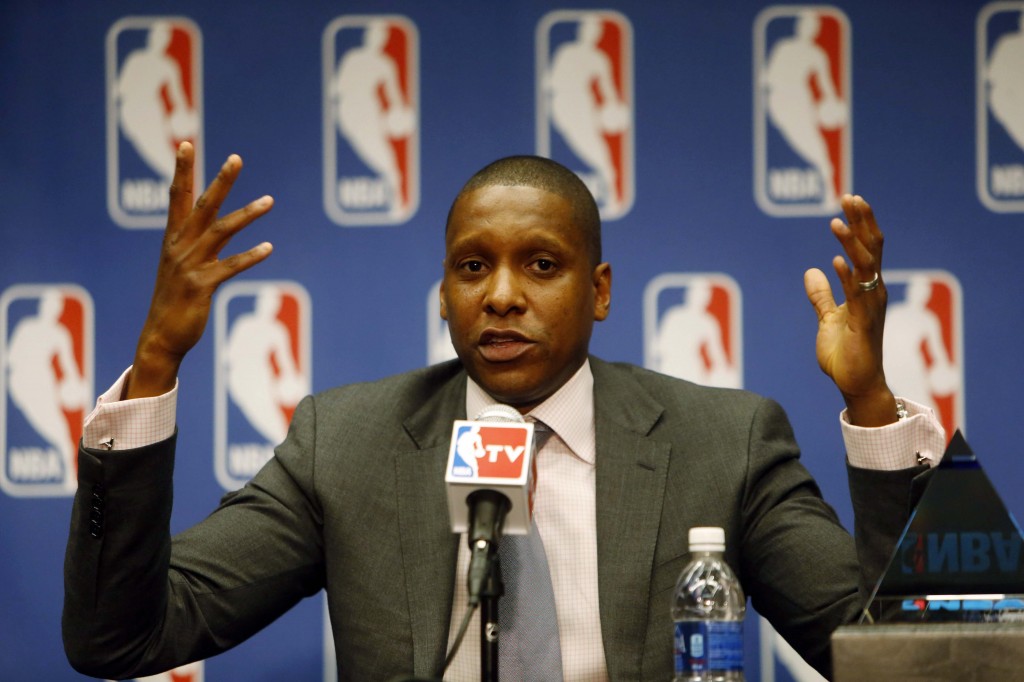Why Masai Ujiri bypassed the trade deadline without making a major move.
The nuttiness of the NBA trade deadline has gone and passed. A number of teams made a last-second move to improve their teams. Portland grabbed Arron Afflalo for a future first. Heat grabbed Goran Dragic. The Sixers grabbed JaVale McGee then traded everyone for picks. The Thunder grabbed Kanter. The Pistons nabbed Reggie Jackson. The Bucks swapped one point guard for two point guards. Shit was popping.
And yet, despite holding multiple movable future assets and expiring salaries to match, Masai Ujiri and the Toronto Raptors decided to stand pat. With all the hoopla and anticipation of reports and rumors, it feels a bit like waking up to no presents under the Christmas tree. The Raptors had holes on the roster and the capability to fill some and yet they stood still.
There’s a very valid case to be made for the Raptors missing their shot at a short-term addition. As fans, we’re not privy to the potential deals offered to Toronto, but based on the moves that were consummated, we have a crude understanding of pricing. Nabbing a player like Wilson Chandler or Luol Deng — someone who could give the Raptors a tangible upgrade somewhere on the roster — was probably within reach (again, we’re not privy to the Raptors’ discussions). It couldn’t have cost more than a first-round pick and a few expirings. If you are of the mindset that the Raptors’ window to contend is now, then yeah, the Raptors should have gone out and grabbed somebody.
But standing still make a lot of sense.
Look at it this way: the Raptors are on a 55-win pace over the last season and a half since dealing Rudy Gay. Now, the Eastern conference hasn’t exactly set the world on fire, but that’s still pretty good. In fact, they have the best record in the East since dealing Gay, so the Raptors aren’t exactly struggling. The team could definitely improve on a number of weak spots, but for the most part, their formula for success has worked.
Then there’s the core of the team. The Raptors are the 10th youngest team in the NBA and all of their core pieces are locked in to reasonable deals. The Raptors’ stars in Kyle Lowry and DeMar DeRozan will earn no more than $23 million combined over the next two seasons and they’re both in their mid-to-late twenties. That’s pretty solid. Key contributors like Patrick Patterson and Jonas Valanciunas are also on the books for the near future. The takeaway here is that the core is cost-effective and young.
The Raptors also have prospects. Terrence Ross has struggled mightily this season, but he and Valanciunas are already contributing members of the team and they only figure to improve. Valanciunas, especially, has taken strides defensively, improving tremendously on the defensive glass and occasionally getting the hang of verticality. Ross, again, has struggled, but he’s shown to be a good 3-point shooter with plenty of quickness and hops. He’ll have one more seasons to show improvement. Given that the team has fared well without his contributions this season, they can afford to be patient. Not to be forgotten, there’s also Bebe Noguiera and Bruno Caboclo. No one knows how they’ll turn out, but there’s two fresh-faced first rounders with plenty of wingspan and potential. The takeaway here is that there’s room for internal growth.
Finally, there’s the future assets in play. The Raptors have $23 million in expirings this offseason and if they renounce all of their free agents, Ujiri will have near-max money to play with. Losing both Amir Johnson and Lou Williams (both free agents) will hurt, but if the Raptors are to take a substantial leap forward, Ujiri will have his coffers full to net a star. And cap room doesn’t just mean free agency. It also permits the Raptors to take on salary in a trade. Toss in the Raptors’ surplus of picks going forward — the crown jewel being the 2016 Knicks/Nuggets pick — and it becomes clear that Toronto has a real shot at making a significant addition.
The Raptors’ flexibility stands in contrast to the playoff landscape in the Eastern conference. Cleveland and Washington are both capped out next season with nothing but a Brendan Haywood fake contract and a mid-level exception to play with. Chicago and Atlanta could potential dig up some cap room, but they have key free agents in Jimmy Butler, Paul Millsap and DeMarre Carroll to account for. Factoring in the market price for their talents, they’re capped out too.
This is not to say that the Raptors are guaranteed to make a huge addition this summer. They aren’t. Free agents need to agree to signing in the frigid tundra that is Toronto, rebuilding teams need to be willing to accept Toronto’s prospects for their disgruntled stars. But regardless of what the actual outcome is, the fact remains that Toronto’s best shot to improve in a significant way is this summer.
Maybe you disagree. Maybe you thought the Raptors should have grabbed someone at the trade deadline — a Luol Deng, a Wilson Chandler, a Taj Gibson — at the expense of flexibility to make a playoff push this year. That’s understandable. Atlanta has played like the best team in the league and LeBron James is LeBron James, but no team in the East feels definitively unbeatable. There’s a small window for the Raptors.
But standing pat with a 55-win squad with plenty of potential to improve? That makes whole a lot of sense too.



